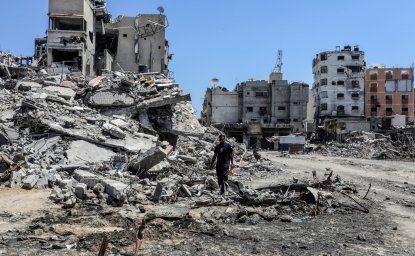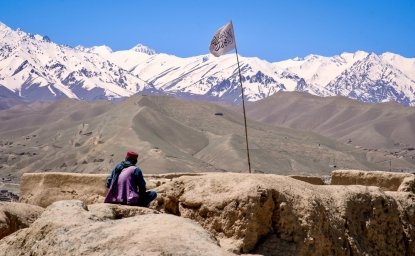The latest war in the Middle East pits a country the size of New Jersey against a territory the size of Philadelphia. Yet the consequences of the conflict between Israel and Hamas—launched on October 7 in bloodthirsty waves of violence—are already rippling worldwide. The global dangers are economic disruption, growing military vulnerabilities, deeper political polarization, new strategic challenges, and the shifting nature of warfare due to belligerent non-state actors.
Economic disruption
First, in an alarming new report, the World Bank warned on October 30 that the conflict between Israel and Gaza could trigger a global economic “shock,” including oil prices soaring up to $150 a barrel and millions going hungry due to higher food prices. It could mirror the crisis during the 1973 war, when Arab members of OPEC, led by Saudi Arabia, imposed an embargo on oil sales to the United States in retaliation for Washington’s decision to re-supply the Israeli military.
The 1973 oil embargo “contributed to an upward spiral in oil prices with global implications,” according to the official State Department history of the crisis. “The price of oil per barrel first doubled, then quadrupled, imposing skyrocketing costs on consumers and structural challenges to the stability of whole national economies.” It also “acutely strained” the US economy, which had grown increasingly dependent on foreign oil.
The new World Bank report outlines the implications a half century later. “The latest conflict in the Middle East comes on the heels of the biggest shock to commodity markets since the 1970s—Russia’s war with Ukraine,” Indermit Gill, the World Bank’s chief economist and senior vice president for development economics, said in an accompanying statement. “Policymakers will need to be vigilant. If the conflict were to escalate, the global economy would face a dual energy shock for the first time in decades—not just from the war in Ukraine but also from the Middle East.”
Military vulnerability
Second, the United States faces the already tangible danger of being sucked into a wider military conflict—a consistent danger in warzones—as an unintended consequence of its deployment in the Middle East. The Pentagon deployed two carrier strike groups with warships that carry more than 150 warplanes as well as abundant missiles. It has also prepped 2,000 troops to go to the world’s most consistently volatile region. The goals are to prevent escalation that draws in other parties or nations and to provide force protection for its own troops.
For all the muscle flexed, however, US forces also create targets for attacks. As of October 30, the Pentagon reported 23 attacks by Iranian proxies that fired drones and rockets on US forces since October 17—14 attacks on sites in Iraq, where 2,500 US forces are deployed, and nine in Syria, where some 900 US forces are based. The Americans are stationed in multiple places, fairly thinly spread out, as part of the ongoing campaign against ISIS—a separate war. Most of the attacks failed to reach their target, the Pentagon reported, but 21 Americans have suffered injuries from those that did.
Hezbollah is today the most heavily armed non-state actor in the world. It has a far larger arsenal than Hamas and is a far greater danger to Israel (and its American allies).
The potential dangers for American forces harken back to a military catastrophe in 1982, when the United States deployed hundreds of Marines as peacekeepers to separate Israel and the Palestinians in Lebanon after Israel’s invasion. Whatever the policy intentions, the peacekeepers ended up getting sucked into Lebanon’s civil war a year later—and becoming a target of the then nascent embryo of Hezbollah. Forty years ago this month, on October 23, 1983, a suicide driver drove into the four-story Marine barracks at dawn, as the men slept, and killed 241 naval personnel. It was the largest loss of US military life in a single incident since Iwo Jima. It was then the largest non-nuclear explosion since World War II. Since then, anti-American militias have surged in numbers and military capabilities. Hezbollah is today the most heavily armed non-state actor in the world. It has a far larger arsenal than Hamas and is a far greater danger to Israel (and its American allies).
Secretary of State Antony Blinken acknowledged the dangers. “We are concerned at the possibility of Iranian proxies escalating their attacks against our own personnel, our own people,” he said on CBS Face the Nation on October 29. “We’re taking every measure to make sure that we can defend them and, if necessary, respond decisively. Not at all what we’re looking for, not at all what we want, but we’ll be prepared if that’s what they choose to do.”
Political Realignment
Third, in a world already tensely polarized, the war has spilled over to distant continents, faraway capitals, and divided college campuses. It has fomented ugly divisions not simply described as pro-Israel or pro-Palestinian. Antisemitism, including death threats to Jewish groups and organizations in the United States, is on the rise in disgusting ways. Meanwhile, hundreds of thousands have turned out in pro-Palestinian demonstrations from London to Kuala Lumpur.
On October 31, several protestors repeatedly disrupted the Congressional testimony of Secretary of State Antony Blinken on U.S. national security issues. "No to the siege of Gaza," one woman, waving a sign, shouted before security ejected her. "Ceasefire now." A crowd in the congressional gallery raised bloodied hands, with "Gaza" written in black paint on their forearms. After several individuals with their own signs were removed, the crowd burst into chants of "ceasefire now!" They, too, were physically ejected. The war has even split NATO allies, with the United States condemning the brutal Hamas atrocities, while Turkish President Recep Tayyip Erdogan labeled Israel an occupying power and denied that Hamas was a terrorist group.
The idea that diplomacy could consolidate a different Middle East—through the Abraham Accords and a new connectedness between Israel and longstanding Arab adversaries—now faces huge hurdles, at minimum, amidst the rival public furies.
The idea that diplomacy could consolidate a different Middle East—through the Abraham Accords and a new connectedness between Israel and longstanding Arab adversaries—now faces huge hurdles, at minimum, amidst the rival public furies. Regional leaders who have engaged with Israel face pressure to back off, or more. The schism in views globally may not end with a cessation of fighting.
New strategic challenges
Fourth, one of the “winners”—which is, at best, a dubious idea when applied to the current complex Mideast conflagration—is China. For almost two years, the United States has been consumed with aiding and arming Ukraine. Now it faces similar commitments to Israel. Meanwhile, Russia is expending its military resources in the draining war in Ukraine. China faces no similar strategic challenges. It is unimpeded in building up its military, expanding its influence far beyond Asia, and channeling its financial resources and diplomatic leverage into a long-term agenda.
In the wider scramble for global influence in the 21st century, China has been doing a deep dive into the so-called Global South of developing nations. “Many Global South nations are sympathetic to Palestine, and the war is therefore an issue China can use to mobilize support for its leadership of developing countries,” Ahmed Aboudouh, a fellow at Chatham House in London, wrote on October 25. Beijing’s long-term objective, he said, is to “degrade” Washington’s global standing by capitalizing on sympathy for Palestinians worldwide. “This in turn helps win backing for Chinese positions on core issues like Xinjiang and Taiwan—and for Xi [Jinping]’s vision of global governance.”
Belligerent non-state actors
Finally, the war in Gaza reflects the challenges of non-state actors—the militias that are not nearly as well armed, or well trained, or well financed as nations with formal armies, navies and air forces.
Finally, the war in Gaza reflects the challenges of non-state actors—the militias that are not nearly as well armed, or well trained, or well financed as nations with formal armies, navies and air forces. Between 1948 and 1973, Israel fought four conventional wars with neighboring states. But for the past 50 years, all of its wars have been with militias—the PLO, then twice with Hezbollah in Lebanon and multiple confrontations with Hamas. In many ways, they have been harder to fight.
The United States faced the same painful challenges twice in Iraq, from 2003 to 2011 and again from 2014 to 2017, and in Afghanistan during its longest war from 2001 to 2021. The ragtag Taliban had no navy or air force, yet it forced out the world’s mightiest military. In Israel, another militia shocked the best-armed state in the Middle East, which may in turn stir other non-state actors. The balance of power between conventional and unconventional—or big armies and small ones—is no longer necessarily a calculable algorithm based on the number of arms and men.
The war has already had global impact in less than a month since Hamas burst across Israel’s security wall in more than 20 places. The longer the war in Gaza plays out, the greater the potential for wider consequences well beyond the Israeli or Palestinian borders. There may be a lot more than five.






